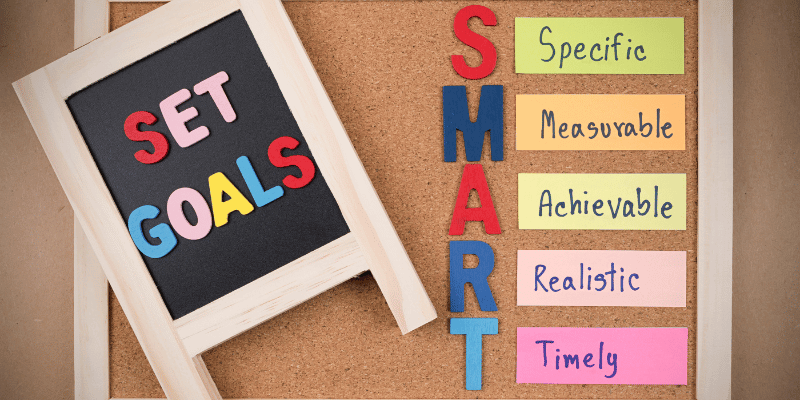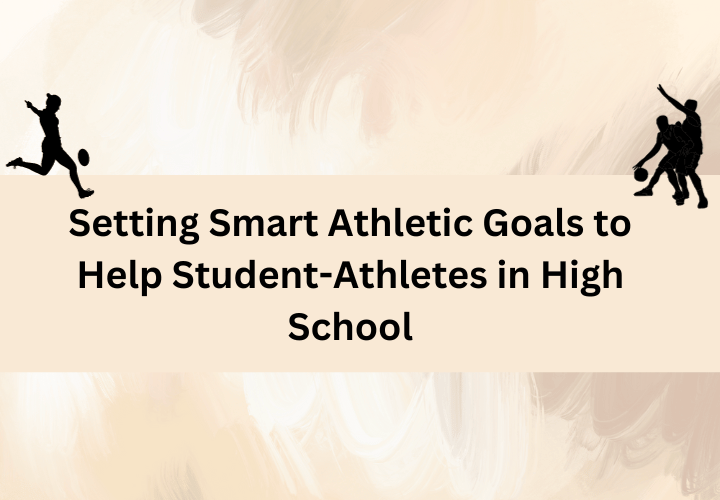There can be no progress without a benchmark and thus goal-setting is important. It ensures advancement and helps one grow. Setting athletic goals for students enhances competition and improves their commitment.
1. Why Goal Setting is Important for a Student Athlete
- It increases focus and provides motivation for student-athletes
Setting athletic goals for students is a way to help them set their targets and focus on them. If there is no goal there can be no comparison to past performances and one cannot keep track of their progress. Therefore, motivation is one of the factors which emphasizes goal setting.
Goals are set with past achievements in mind, so once a goal is achieved there is incentive to do better. Without desire, it will be very difficult to achieve good things.
- It helps in measuring the progress and performance of student-athletes
It is a well-known fact that the goals are set to break records and thus, it establishes a way to compare past performances. If an individual has been the top most athlete the others will try to beat him by setting similar goals.
The objective of everyone is to be the best and to make sure they achieve what they want. Goals are set by comparison with past efforts; this helps them understand where they are now and what they want to achieve, which helps a player Improve and enhance development.
2. Types of Athletic Goals for a Student-Athlete
- Outcome Goals in Athletics
The outcome goal, as the name specifies, has a focus on the outcome. The desire for achievement of a specific outcome does not have much impact on the development of the student as it is just about achieving a particular result which can be any way that you find suitable. This creates a sense of stress due to the manner the goals are set.
The outcome goal is not under one’s control as it has a major impact on how the other athletes perform.
Let’s understand this with an example; a basketball player as an individual has a goal of performing to the best of his capability so that the team can win the match.
Thus, the outcome goal above would be to make the team win. Similarly, a high school student would have an outcome goal of performing in a way that he can pass the exam with good marks.
In both the above cases, the individuals prioritize the outcome or the ultimate result.
- Performance Goals in Athletics
The second type of athletic goals for students is Performance goals. Performance goal also has an emphasis on the outcome, but it involves accomplishing certain standards along with achieving the end result.
Unlike outcome goals, the performance goal is more under your control and performance is what matters the most here.
For instance, you’re not a brilliant student in your grade. The professor wants you to pass but with a good percentage in science and math as compared to your previous semester. So here, getting good grades in science and math is in your control and this does not have any impact on how others perform and it also has a commitment towards your growth.
- Process Goals in Athletics
Process goal is a much wider term when compared to the other two. To achieve the outcome, the focus is on mastering the skill and process. When a person has complete knowledge of how to perform a skill, confidence is reflected in his attitude. He would be less stressed and thus there would be no anxiety.
In other words, process goals give complete control to the individual over the outcome.
3. Creating S.M.A.R.T Athletic Goals


- Specific Athletic Goals
The more specific the goals, the better the performance. When you know what you need to achieve, you can keep track of where you are and where you want to be. If your goal is clear, you will effectively score the best.
Specific goals help in creating a step-by-step blueprint of how to achieve the end result, which is quite logical in athletics.
- Measurable Athletic Goals
To be able to estimate how productive you were in the entirety, the goals should be measurable. If you set your goals that cannot be measured, then you cannot check if the objective was met or not, and thus there would be no use for goal setting.
The college coaches help the student-athletes in goal setting at the beginner level. So, the student level is where the journey begins.
- Achievable Athletic Goals
Even if the goals are clear and specific but cannot be attained by you at the moment, it is of no use. Thus, one of the very significant aspects to be kept in mind when goal setting is that something achievable or realistic should be a part of the goal.
If goals aren’t achievable, it creates a sense of discouragement in the student-athlete and may lead to the downfall of the athletic career if not handled carefully and smartly or may also distract him.
- Relevant Athletic Goals
The relevancy of the goals is important as it should have some positive impact on the student, else it would be of no use.
To be precise, the goals you set are made keeping in mind the impact they have on the outcome. If the goal does not make an impact, then it is of no use. Rather, a goal should be such that it helps in your improvement. Therefore, relevance is important.
- Time-Bound Athletic Goals
One of the things that should be kept in mind while setting goals is that it should be time-bound.
If the goals are not reached within a certain period of time, they will take a long time to be achieved, and if they are not achieved within a certain period of time, they will not have the same meaning. On the other hand, the purpose of time also makes people aware of time management.
4. Setting Individual and Team Athletic Goals
- Aligning Individual Athletic Goals to Team Goals
It is the coach who should ensure that the alignment of the team goals and individual goals is done well. Along with the goals when values are also focused on, it allows giving importance to individual goals as well.
A tip to effectively align the goals is to take up an activity before going on the field. The coaches should list the team goals and the students will make a list of their specific personal goals.
The high-priority team goals are then discussed to be aligned in such a way that the individual goals are met as efficiently as possible. This way, it creates a space for everyone to get an opportunity for their skill enhancement.
- Balance between Individual Development and Team Cohesion with Athletic Goals
Since old times, the importance of Coordination amongst team members has been recognized. The individuals should have a sense of oneness and this is when they would be able to consistently perform better and achieve their goals.
Once the women’s coach of the US basketball team claimed that the program of bringing and engaging the players together was a great idea as it creates social cohesion and helps them gel up well with one another.
It is closely understood that some or the other goals will be missed when it comes to goal alignment when priority is given to the ones that carry a high level of importance. Thus here what works is teammate cohesion, for which special programs are conducted.
5. Reevaluating Athletic Goals during the Season
- Adjust Athletic Goals Based on Performance
There are both long-term goals and goals set for a shorter period of time or ones that can be achieved within a shorter span. There can be a need to adjust these goals based on how the athlete performs.
When tougher goals are set, it develops persistence and thus increases commitment. Also, to develop a newness, the goals are adjusted, keeping in mind the achievements and performance on an individual level.
- Setting New Athletic Goals on the achievement of the previous ones
Other than the adjustment of goals from time to time, the older goals are replaced with the newer ones as those have been achieved.
When a particular performance standard or benchmark has been achieved, there is a need to refer to the competition and demand of the hour to set new goals. A weekly schedule is lined out for adjustment of goals. However, setting new goals is done on the achievement of the previous ones.
6. Using Athletic Objectives to Improve Academic Performance and Develop Character in College
- Athletic Goal Setting Builds Focus, Resilience and Self-Confidence
Physical activity has great advantages in terms of improving cognitive skills, which can be communication improvement and other similar skills.
These cannot be developed overnight but with continuous efforts, both the attitude and behavior of a student-athlete get updated and have a positive impact on the academic career.
Goal setting improves focus and thus impacts building strong concentration. All these have a fruitful impact on the overall personality and help you achieve self-confidence.
- Overcoming Challenges to Achieve Athletic Goals Builds Character
Challenges become a part of an athlete’s life. Where winning may boost your confidence, losing may also make you resilient. Thus, this is a complete package for building a strong character.
The sacrifice one makes helps him understand the value of things. When you face challenges and manage to overcome those with your own thoughtfulness, it builds confidence in yourself. Thus, athletics not only helps gain physical fitness but improves mental abilities.
A great win is more than enough to overwhelm an individual but how to control one’s emotions and keep on consistently overcoming challenges in what athletics teach.
Conclusion: Why goal setting is important for student–athletes?
First of all, Goal setting is important to set a criterion as to where we are and where we want to be. Achievement would be of no use if there is no standard set. Therefore, athletic goals for students are set in order to establish criteria for them that they should achieve.
The progress and performance of a student-athlete is measured as per the goals set. If he is able to achieve the goal, another higher goal awaits him and this would be a motivating factor for him as he will be crossing the hurdles one by one.
Can you ever imagine if you did not have any goal to focus on and even though you gave your best, there is no way to measure how you have been, the efforts would be of no use and there would be huge discouragement?
Motivation is something that helps everyone keep going and performing even better, be it any field in life and when a goal is achieved, it helps in boosting your spirits even higher and helps in inculcating a habit of being the best when you are appreciated.
Thus, goal setting has a wider impact on athletes and their performance. The NCAA organization was started with the same aim of promoting and protecting young college athletes.
FAQ’s
- What is an example of a short-term goal for an athlete?
The long-term goals are broken into a few short-term goals which are to make a way to accomplish the long-term goal at the end. The short-term goals are adjustable by nature, which can be done as per the need.
An example of a short-term goal would be maintaining a healthy diet for a few months, or reaching a longer distance in less time for a sprinter, athletic goals for students
- What is a smart goal for physical activity?
A smart goal for physical activity is one that should be specific, measurable, achievable, relevant, and time-bound.
Specific– The goals should be clear to the athlete so that he can invest his efforts in the correct way to achieve the goals.
Measurable – The goals should be such that they can be compared to past performances to know the progress and status of improvement.
Achievable – If realistic goals are not set, then they cannot be achieved. Goals should be attainable.
Relevant – Goals should be based on reality and one which can be relevant. If it is of no use to the athlete, then there won’t be any sense wasting time and energy on it.
Time-Bound –If the goals are set but are not time-based, then they may lose their importance if not achieved within the required time. It is a wrong way to set goals where there is no specification of a time limit for achieving the goals.
- What are Examples of Smart Goals for Athletes?
A smart goal for a basketball player can be to work on their goal percentage and increase it by 15% within a time span of 1 month.
The above goal is specific, can be measured very easily, is achievable, of course, and is also relevant to the field of the resource and is to be achieved within a time range. Thus, fulfilling the principle of being a smart goal.
- What are Performance Goals for Athletes?
The performance goal for an athlete can be winning as a team along with defending 6 goals on an individual level. Here, the ultimate goal is winning but involves meeting a personal standard, i.e., increased goal-defending percentage.
Therefore, the performance goal is achieving the desired outcome along with accomplishing a particular standard of performance.
- What are the different types of athletic goals?
The three main types of athletic goals are – outcome goals, performance goals, and process goals.
Outcome goal – You believe in getting the desired outcome, be it anyway. The focus is only on the outcome.
Performance goal– Achieving the desired outcome along with accomplishing the desired standard of performance.
Process Goals – Developing a particular skill for attaining the desired outcome. This has a wider perspective as compared to the other two goals.



